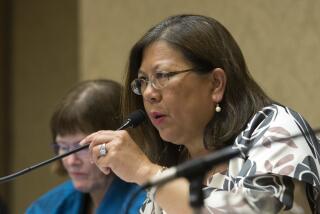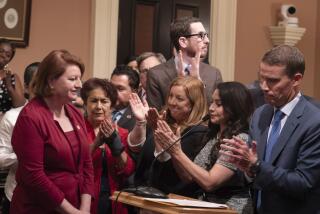Margaret Thatcher, Hillary Clinton and the glass ceiling
Margaret Thatcher was a historic, transformational figure who did many amazing and contradictory things in her life. She was a free market authoritarian who metaphorically bashed her opponents with her famous handbag until they submitted to her will.
In her drive to dig Britain out of its post-war doldrums and to reverse what she saw as its horrifying descent into Socialism, she ignored the misery caused by her policies as the country was transformed from a welfare state to a more brutal, capitalist endeavor.
She was Britain’s first and only female prime minister. But she was no feminist icon.
PHOTOS: Margaret Thatcher | 1925 - 2013
Despite the occasional anecdote about how she had to rush off to buy bacon for her husband because no one else could be trusted to buy the right kind, Thatcher publicly embodied few of what we identify as the classic female traits -- nurturing, sensitive, collegial, flexible -- that experts tell us repeatedly could improve politics and the professions. Even the most feminine symbol associated with her -- her handbag -- became a symbol of that classic male trait, aggression.
“I don’t feel sorry for people,” Thatcher once said after touring an area with 20% unemployment. “Feeling sorry for someone does nothing.”
The most famous American female politician, former Secretary of State Hillary Clinton, who has worked tirelessly for the rights of women and girls, is associated with the phrase “It takes a village to raise a child.” Thatcher’s equivalent: “There is no such thing as society.”
For these reasons, I had to chuckle this morning when I read part of President Obama’s statement of condolence about Thatcher. “As a grocer’s daughter who rose to become Britain’s first female prime minister,” he said, “she stands as an example to our daughters that there is no glass ceiling that can’t be shattered.”
It’s been 23 years since Thatcher left office, essentially deposed in a power struggle with her own conservative allies. How many British female prime ministers have come after her? How many female U.S. presidents have we had since then?
I can find nothing in the record that shows she had an interest in blazing a path for women. She was criticized for failing to bring more women into the government. In her New York Times obituary, she is quoted as once having said: “The battle for women’s rights has largely been won. I hate these strident tones we hear from some women’s libbers.”
TIMELINE: Thatcher’s remarkable life
She could only tolerate her own strident tones, I guess.
I met her once, in the late 1980s, and we talked about fashion, if you can believe it. But that was because it was London Fashion Week, and I was part of a contingent of American and British fashion editors invited to 10 Downing Street for a reception. She was very pleasant, but she was all business.
“Lean In,” the new advice book for professional women by Facebook COO Sheryl Sandberg, is full of grim statistics about women’s standing in the public sphere: only 22 of the world’s 197 heads of state are women, only 21 of the Fortune 500 CEOs are women, women hold only 14% of executive officer positions, 16% of board seats, and just 18% of U.S. congressional seats.
“The blunt truth,” concludes Sandberg, “is that men still run the world.”
Thatcher was an extraordinary woman, absolutely fearless, unflinching and seemingly without an ounce of self-doubt.
“She was very macho,” her former press secretary told the Los Angeles Times. “She was determined to demonstrate she could beat the men.”
Beat the men she did.
But she shouldn’t be celebrated for blazing trails for women. By sheer will, she hacked open her own path to the top, then let it close behind her.
More to Read
Start your day right
Sign up for Essential California for news, features and recommendations from the L.A. Times and beyond in your inbox six days a week.
You may occasionally receive promotional content from the Los Angeles Times.







